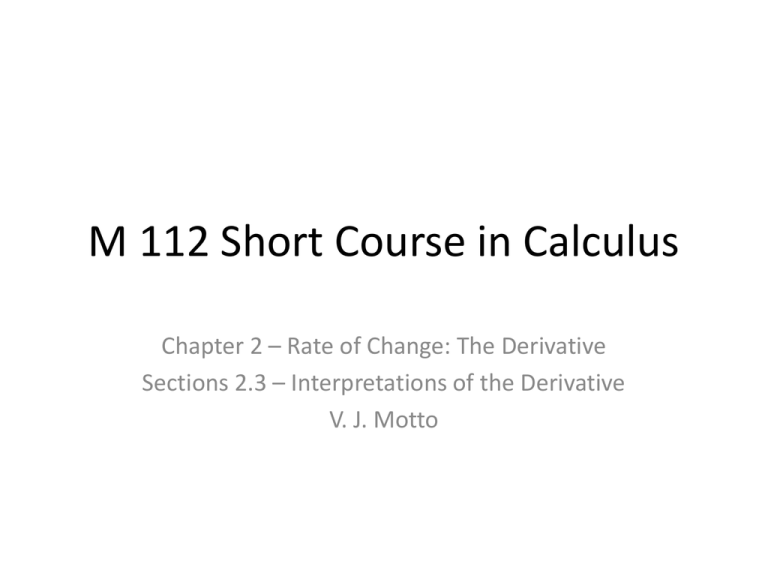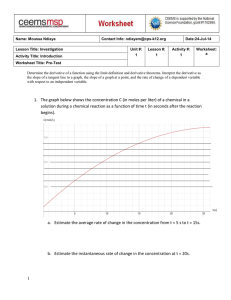Solution - Vincesplace
advertisement

M 112 Short Course in Calculus Chapter 2 – Rate of Change: The Derivative Sections 2.3 – Interpretations of the Derivative V. J. Motto An Alternative Notation for the Derivative - Leibniz An alternative notation for derivatives was introduced by the German mathematician Gottfried Wilhelm Leibniz (1646–1716) when calculus was first being developed. We know that f′(x) is approximated by the average rate of change over a small interval. If y = f(x), then the average rate of change is given by y/x. For small x, we have y f '( x) x Leibniz’s notation for the derivative, dy/dx, is meant to remind us of this. If y = f(x), then we write dy f '( x) dx The notation dy/dx is useful for determining the units for the derivative: the units for dy/dx are the units for y divided by (or “per”) the units for x. Thus, 3/23/2016 d ( y ) means “the derivative of y with respect to x.” dx 2 • The units of the derivative of a function are the units of the dependent variable divided by the units of the independent variable. In other words, the units of dA/dB are the units of A divided by the units of B. • If the derivative of a function is not changing rapidly near a point, then the derivative is approximately equal to the change in the function when the independent variable increases by 1 unit. 3/23/2016 3 Example 1 (page 102) The cost C (in dollars) of building a house A square feet in area is given by the function C = f(A). What are the units and the practical interpretation of the function f′(A)? Solution In the Leibniz notation, f '( A) dC dA This is a cost divided by an area, so it is measured in dollars per square foot. You can think of dC as the extra cost of building an extra dA square feet of house. f′(A) is approximately the cost per square foot of the extra area involved in building a slightly larger house. It is called the marginal cost. 3/23/2016 4 Example 2 (page 103) Solution In the Leibniz notation, Since C is measured in dollars and T is measured in tons, dC/dT is measured in dollars per ton. You can think of dC as the extra cost of extracting an extra dT tons of ore. So the statement says that when 2000 tons of ore have already been extracted from the mine, the cost of extracting the next ton is approximately $100. Another way of saying this is that it costs about $100 to extract the 2001st ton. 3/23/2016 5 Example 3 (page 103) If q = f(p) gives the number of thousands of tons of zinc produced when the price is p dollars per ton, then what are the units and the meaning of dq 0.2 dp p 900 Solution The units of dq/dp are the units of q over the units of p, or thousands of tons per dollar. You can think of dq as the extra zinc produced when the price increases by dp. The statement dq dp p 900 f '(900) 0.2 thousand tons per dollar tells us that the instantaneous rate of change of q with respect to p is 0.2 when p = 900. This means that when the price is $900, the quantity produced increases by about 0.2 thousand tons, or 200 tons for a one-dollar increase in price. 3/23/2016 6 Example 4 (page 103) The time, L (in hours), that a drug stays in a person’s system is a function of the quantity administered, q, in mg, so L = f(q). (a) Interpret the statement f(10) = 6. Give units for the numbers 10 and 6. (b) Write the derivative of the function L = f(q) in Leibniz notation. If f′(10) = 0.5, what are the units of the 0.5? (c) Interpret the statement f′(10) = 0.5 in terms of dose and duration. Solution (a) We know that f(q) = L. In the statement f(10) = 6, we have q = 10 and L = 6, so the units are 10 mg and 6 hours. The statement f(10) = 6 tells us that a dose of 10 mg lasts 6 hours. 3/23/2016 7 Solution (continued) (b) Since L = f(q), we see that L depends on q. The derivative of this function is dL/dq. Since L is in hours and q is in mg, the units of the derivative are hours per mg. In the statement f′(10) = 0.5, the 0.5 is the derivative and the units are hours per mg. (c) The statement f′(10) = 0.5 tells us that, at a dose of 10 mg, the instantaneous rate of change of duration is 0.5 hour per mg. In other words, if we increase the dose by 1 mg, the drug stays in the body approximately 30 minutes longer. Comments • f′(10) = 0.5 tells us that a 1 mg increase in dose leads to about a 0.5-hour increase in duration. • If, on the other hand, we had had f′(10) = 20, we would have known that a 1-mg increase in dose leads to about a 20-hour increase in duration. • Thus the derivative is the multiplier relating changes in dose to changes in duration. • The magnitude of the derivative tells us how sensitive the time is to changes in dose. 3/23/2016 8 Example 5 (page 104) If the velocity of a body at time t seconds is measured in meters/sec, what are the units of the acceleration? Solution Since we define the derivative of velocity, dv/dt, as acceleration, the units of acceleration are units of velocity divided by units of time, or (meters/sec)/sec, written meters/sec2. 3/23/2016 9 Using the Derivative to Estimate Values of a Function Since the derivative tells us how fast the value of a function is changing, we can use the derivative at a point to estimate values of the function at nearby points. Local Linear Approximation If y = f(x) and Δy ≈ f’(x) Δx. Then for x near a and Δx = x – a f(x) ≈ f(a) + f’(a) Δx This is called the Tangent Line Approximation. 3/23/2016 10 Example 6 (page 103) Fertilizers can improve agricultural production. A Cornell University study6 on maize (corn) production in Kenya found that the average value, y = f(x), in Kenyan shillings of the yearly maize production from an average plot of land is a function of the quantity, x, of fertilizer used in kilograms. (The shilling is the Kenyan unit of currency.) (a) Interpret the statements f(5) = 11,500 and f′(5) = 350. (b) Use the statements in part (a) to estimate f(6) and f(10). (c) The value of the derivative, f′, is increasing for x near 5. Which estimate in part (b) is more reliable? 3/23/2016 11 Solution (a) The statement f(5) = 11,500 tells us that y = 11,500 when x = 5. This means that if 5 kg of fertilizer are applied, maize worth 11,500 Kenyan shillings is produced. Since the derivative is dy/dx, the statement f′(5) = 350 tells us that dy 350 when x = 5. dx This means that if the amount of fertilizer used is 5 kg and increases by 1 kg, then maize production increases by about 350 Kenyan shillings. (b) We want to estimate f(6), that is the production when 6 kg of fertilizer are used. If instead of 5 kg of fertilizer, one more kilogram is used, giving 6 kg altogether, we expect production, in Kenyan shillings, to increase from 11,500 by about 350. Thus, f(6) ≈ 11,500 + 350 = 11,850. Similarly, if 5 kg more fertilizer is used, so 10 kg are used altogether, we expect production to increase by about 5 ・ 350 = 1750 Kenyan shillings, so production is approximately f(10) ≈ 11,500 + 1750 = 13,250. 3/23/2016 12 Solution (c) To estimate f(6), we assume that production increases at rate of 350 Kenyan shillings per kilogram between x = 5 and x = 6 kg. To estimate f(10), we assume that production continues to increase at the same rate all the way from x = 5 to x = 10 kg. Since the derivative is increasing for x near 5, the estimate of f(6) is more reliable. 3/23/2016 13 Basic Definition Relative Rate of Change The relative rate of change of y = f(t) at t = a is defined to be Relative rate of change of y at a 3/23/2016 14 Example 7 (page 105) Annual world soybean production, W = f(t), in million tons, is a function of t years since the start of 2000. (a) Interpret the statements f(8) = 253 and f′(8) = 17 in terms of soybean production. (b) Calculate the relative rate of change of W at t = 8; interpret it in terms of soybean production. Solution (a) The statement f(8) = 253 tells us that 253 million tons of soybeans were produced in the year 2008. The statement f′(8) = 17 tells us that in 2008 annual soybean production was increasing at a rate of 17 million tons per year. (b) We have Relative rate of change of soybean production f '(8) 17 0.067 f (9) 253 In 2008, annual soybean production was increasing at a rate of 6.7% per year. 3/23/2016 15




